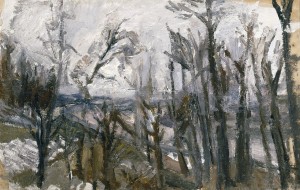In the spring, on the second-to-last Saturday of March, Koroteev went to the church of the Joy of All Who Sorrow on Bolshoi Ordynka Street. Each year on this night the choir would sing Sergei Rachmaninoff’s Vespers. At time in the Spring preceding the Easter holiday and, what’s more, in April, the landscapes of Russia’s middle belt are still somehow devoid of color, filthy, but they shine, permeated and filled with sunlight. The snow has only just left, and still not from everywhere; in some places the earth is awash in puddles and glistens so that it’s painful to look at while in other places it’s already turned to dust. This distinctive state of nature often shows up in Koroteev’s paintings. In them, this time of year, filled with the anticipation of summer and rebirth of life, becomes a reflection of the condition of a person, responds to his thoughts and his expectations; he works, understanding that it is only in his long, individual labor that he, a person who was given such a time and the conditions of such a historical epoch, is not bound by these conditions, or these conventions, and surpasses them, taking the form of a simple, living person that has brought his life experience to the world. Today and, most likely, always this experience is extremely valuable. Such art also involves a resurrection to life. In it there takes place a discovery of the world that is unlike the clichéd images and discoveries of the living world. It is unique in each person’s individual experience, but at the same time, it is the same for all of humanity, it unites all people that have lived before and are living now and those who have yet to be born. Here emptiness comes to an end because the languages of conventional reality die away. Koroteev spoke of the world in such a modern language, that is, so precisely and deeply felt, that this painting, this language, when set among the other languages of painting from different times, can seem the only one that is correct, the only one that is possible and eternal.
Vasily Andreevich Koroteev’s painting brings to mind the words his daughter, Nadezhda Vasilievna Koroteeva, spoke concerning him: “The surety of despair is needed in order to paint in such a way. I remember my father and his ability to throw on a brushstroke with anger: one is not simply born this way.”
These words are consistent with Lev Shestov’s thoughts, which this philosopher wrote in the book In Job’s Balances. Wanderings Through Souls: “Only a person lost in eternity and left to himself and his own measureless despair is capable of turning his gaze to the final truth…”
A little earlier Shestov writes: “To see the truth it takes more than just a quick eye, sharp wit, attentiveness and the like… one also needs to be capable of the utmost in self-denial. And not in the usual sense. It’s not enough that a person agree to live in filth and cold, to endure humiliation and sickness and to fry inside of Phalaris’s bull. One also needs that, of which the Psalmist sings: to melt inside, to shatter and break the skeleton of one’s soul, that which is considered to be the foundation of our being, all that which is prepared, the definition and identification of the concepts in which we have grown accustomed to seeing veritates aeternae. To feel that everything within you has become fluid; that the forms are not provided in advance in the eternal law but rather that they must be personally created every hour and every minute.”



